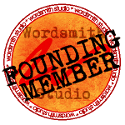
Baby pictures. A glimpse into harsh revisions occurring with my poor Wake, last week. Classic: either move this with a happy star to the next chapter — or cut it and pillage for single words/details to keep. (c. Elissa Field, no repro w-out written permission)
If you’ve read my last several posts, you know that I’ve been sharing the varied processes I’ve been going through in daily revisions to my novel. If you want to read other posts in the series, a list of links is at the end, below.
As I’ve said before, my novel draft is in mid-process revisions. That is,
- I am no longer drafting the novel: the full story is written from opening through final scene, including external conflict, internal conflicts for key characters, settings and the major scenes, and all the research is completed.
- On the other hand, I’m still making decisions and answering questions about what I’ve written, addressing inconsistencies, moving large sections around, or deleting, and rewriting.
- Just as I’m no longer drafting, I’m also not editing at the sentence level, yet, as I will during final revisions. I may correct word choice, sentence structure or punctuation as I notice them, but I’m still in a more “construction” phase than the final process of polishing to send to an editor.
I say this to recognize that there is a point between mid-process and final revisions, where it helps to be able to run through a series of steps to test for common errors — and that is the point of today’s post.
* * * * *
A Hit List of 6 Steps to Apply to Target Weaknesses in a Draft
Finishing the middle process and approaching final revisions is a good time to consider some common errors that editors, agents and other pros report finding in novel drafts submitted as “finished.” One of the reasons this stage of revision can be such a concern is that a writer may have a blind spot to errors that editors and agents find obvious.
The hit list below offers 6 practical steps that can help you target and fix weaknesses remaining in your draft. Inspiration comes, in part, from the advice for writers posted on the submissions page at the Pirate’s Alley Faulkner Society’s prize for fiction, but also from resources like “query tips” on Twitter, other articles from editors and agents, and my own experience.
1. Run Spell Check
This one sounds obvious. Of course: check for misspellings or errors in capitalization. But also watch for inconsistent spellings of proper names you invented – spell check won’t catch these unless you add them to its dictionary. Did you ever change names of characters or locations? It’s a common error to not catch all inconsistencies before submitting. Read for misused homophones, which spell-check might not catch. Yup, we all swap out there/their/they’re, etc., when typing fast. Beyond spelling, check grammar and punctuation — use the best spell-checking tool available to you. For example, if you have both Scrivener and Word, use the spell-checker in Word. It’s smarter. Lastly, the skimming nature of bouncing through your document with spell check can also help you notice other subtle issues — for example, consider “overused words,” below.
2. Bad Phrasing and Passive Tenses
Use your software’s search tool to target lame word usage. You can target passive word choice by searching “there is,” “there are” and “there was/were.” Search helping verbs and -ing to avoid overuse of vague or passive verb constructions. I’ve heard at least one pro say it’s a newbie error to use constructions with “become”/”becoming.” For example, “He became scared,” rather than, “Fear ran through him.” An odd example of stilted/passive wording mentioned by the Pirate’s Alley Faulkner Society was overuse of the word “the.” They say (link below) that one non-winning novel submission to the Society’s contest in 2012 “used the word ‘the’ 10,001 times. At least half could easily have been eliminated.” To make the point, they revised sample lines to show how wording could have been more vivid. Searching any of these words might help target where the usage is fitting or where it might be written more effectively.
3. Overused Words or Images
We all have certain words or images we overuse — do you know yours? Skimming during spellcheck may increase your awareness. If not, listen for them as you reread or ask a beta reader to notice them for you. Often, these can be unexpected. For example, I was surprised to find I’d used “horse” 47 times in this draft which is not about horses. Only 4 scenes required a horse and the random mentions took their power away (why all the horses? It’s an autobiographical misfire as my family has horses in our background – while my characters do not). If you have a particular mood or image in mind as you write, you could find it overly pervasive. Some of my overused words, for example, were dark, silver, memory, shadow and light. They are key mood words, but I needed to use them in the most powerful moments, not, um, everywhere. Overused words create vagueness rather than meaning, so targeting them is an opportunity to seed more powerful detail. “Sitting in darkness” is one thing; “sleeping in the cold shadows of a hedge along the drive” moves the story and conflict, not just mood.
4. Is it Over-written?
In early drafts, it’s easy to write reams of words that aren’t yet anchored in the specifics of story details you didn’t yet know. There and in other places, if you suspect a sentence or paragraph is too wordy or not serving a purpose, use a highlighter to mark only the words that matter. Could you edit to just those? What if someone asked you to post a line to Twitter? If you were limited to 140 characters, what words would drop out? At the same time, highlighting key information can help you avoid deleting an important detail. Let’s say it’s tempting to delete a cringe-worthy scene from a early draft — highlighting any key information revealed by that scene (“a gun was stored on the top shelf”) will help you make sure to save and relocate it to another scene, so you don’t create an inadvertent hole in the story.
5. Target Dialogue
Personally, I write full conversations between characters during drafting, but delete all dialogue except the lines with power during revision. Dialogue problems are a common issue to keep drafts from succeeding. Advice for revision includes reducing wordcounts and improving story flow by removing unnecessary dialogue tags. Other advice from pros suggest editing for pompous speeches or voice that does not ring true, or excessive reliance on lengthy dialogue for information dumps. Unless dialect is key to your story, avoid overuse of phonetic spellings and spacers (“I, like, well, um, really,” she paused..). Every line of dialogue should cleanly, clearly carry its weight to activate the story; weak dialogue kills.
6. Senses Should Sing
Writer Donna Gephart recently shared the advice that 80% of the brain’s perception is related to sight (read her mini-lesson as part of Teachers Write! here). Awesome. Except that may mean that writing is overly preoccupied with details related to eyes and unnecessary sight direction. “He turned and looked toward the dock. The boat was on fire,” is a great example of unnecessary sight direction. Better: “The boat was in flames.” The reader doesn’t need to be told the MC turned and looked. Target “looked,” “turned,” “saw,” “glanced,” and other directions related to eyes, and consider whether they’re really needed. What is really revealed, and is there a better way to reveal this? And go beyond sight details. Where could you add detail from the other 4 senses — especially in places where you want to pull a reader deeper? Use sensory details that develop character (name 3 things the character would notice that no one else would) or move the story. Remove details that are clichéd, assumed or reveal nothing about the character or story.
* * * * *
Links to other posts from my Revision Series are at the end of this post.
For more on common novel errors:
- Jane Friedman: 13 Most Common Errors on a Novel’s First Page
- Link mentioned in the post: Pirate’s Alley Faulker Award for Fiction
- Superhero Nation: 5 Common Mistakes for First Time Novelists
- Chuck Sambuchino: 7 Reasons Agents Stop Reading Your First Chapter
* * * * *
How About You?
Do you consider your WIP to be in a drafting stage, in mid-process revisions, or are you polishing to submit for publication?
Do any of these 6 steps ring true for you? Have you tried a similar approach, or do you have a trick of your own to share?
What “common errors” do you worry most about? Or, do you worry about having a blind spot and not be able to notice errors? (Which hints at my next hurdle: the importance of getting feedback from beta readers…)
Best wishes to you, wherever you are in the writing, revising or publication process.
* * * * *
If you like this blog, be sure to subscribe using WordPress’s +follow option, or via email or RSS feed. I love to connect with like-minded readers and writers!
Recent Posts:
- Friday Links for Writers: 07.12.13
- Motivated to Write: 12 Tools to Get Writing Now
- My Summer Reading List 2013
- Popular “vintage” post: Novel Writing: Grace Paley – How Internal & External Conflict Build Story
More Posts in this Novel Revision Strategies series:


















Thanks for the list, I’ll have to tuck this away for when I go back to writing =)
LikeLike
Thanks, Stephanie. It was great to connect with you on the July Blog Challenge, and I’m off to check out your site.
LikeLike
These are excellent tips. One of my current WIP short stories is 4 pages too long. I’m going to have to print it and highlight it according to your tips to fit the requirements. It’s going to be fun! Thanks for the tips, good luck with revisions. :)
LikeLike
Sopphey, that’s interesting to hear. If you think of it, come back and let us know how it goes with the story. I’ve used this highlighting trick to simplify SO many decisions about what to keep and what to cut. If I’m not tempted to highlight anything as important, it eases the doubt about cutting. On the other hand, it’s helped me know when maybe sluggish writing made a passage seem dull, but lots of important information was contained, so it was worth fixing the writing rather than deleting. Good luck with your story (is this the one you were working on when we did word sprints?).
LikeLike
Pingback: How to Edit | writerdissection
Thanks for the mention. It is great to hear that my editing strategies have added to your own. Best wishes with your writing.
LikeLike